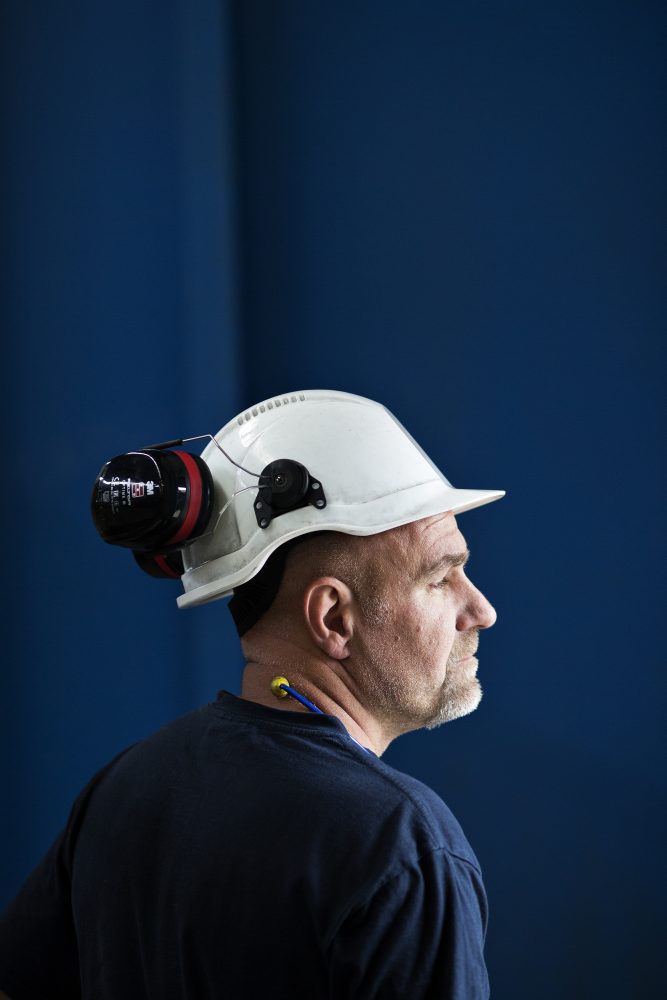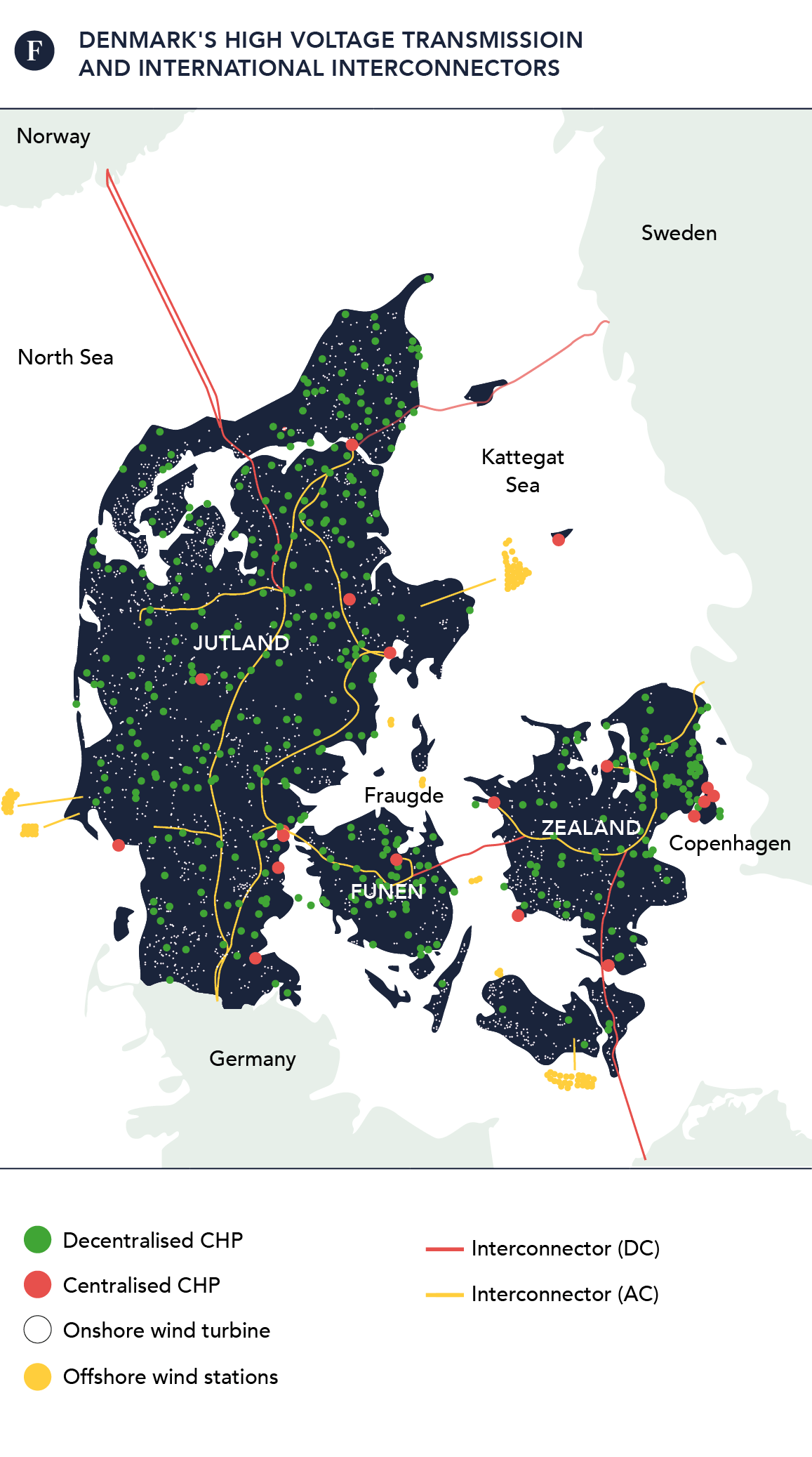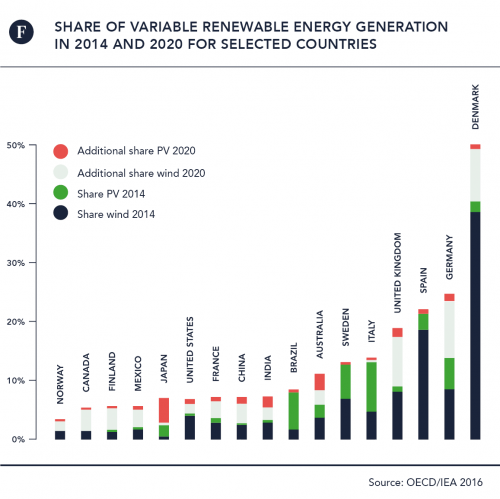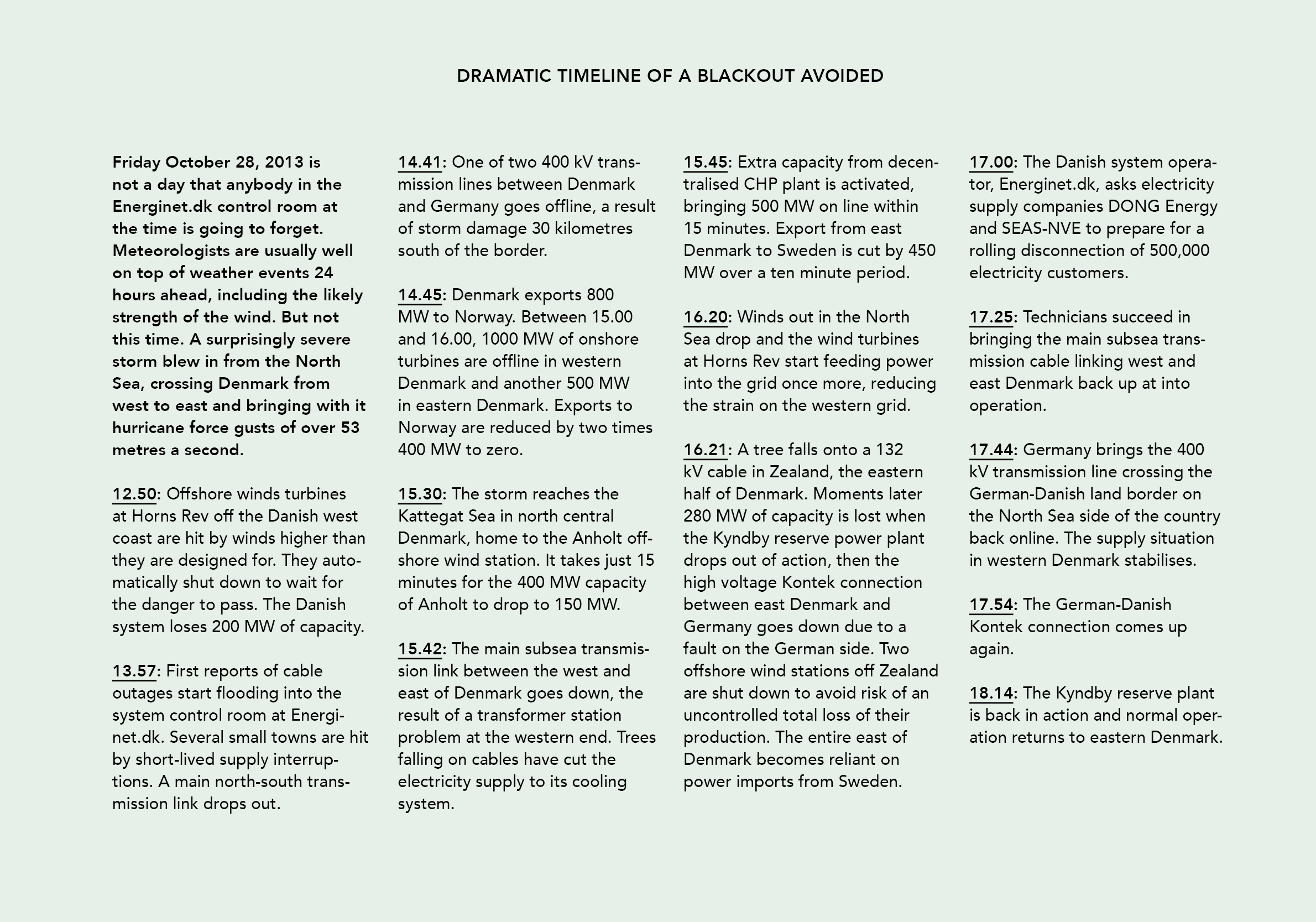At any given moment wind power supplies between zero and 140% of Denmark’s electricity. A robust grid network, flexible operation of power production and a well functioning electricity network make sure the lights stay on, also in hurricane-force winds.
A FULLY INTEGRATED RENEWABLE ENERGY SYSTEM
Changing an entire energy system is never going to be an easy job. Denmark, however, has long demonstrated that large-scale integration of wind energy into the national grid requires no compromise with security of supply. Electricity is on tap to Danes 99.997% of the time, the highest availability in Europe.
By 2020 this Nordic country will increase the proportion of wind generation in its electricity supply to over 50%, from 42% in 2015, with no relaxation of its tough quality standards. Internationally, recognition is growing that wind can play a significant part in transitioning to a low carbon economy. The International Energy Agency, inspired by Denmark’s example, states that for many countries there are no technical barriers to integrating at least 40% wind in the supply mix, provided sufficient flexibility is built into the power system to balance the ups and downs of wind generation. The record for wind’s share of supply in Denmark is currently 140%; theoretically, that share can drop to zero.
The key to Denmark’s transition to climate-friendly wind energy, without sacrificing supply security, is a well functioning market, a muscular electrical infrastructure, flexible combined heat and power (CHP) stations and balancing Norwegian hydro power with Danish wind production, to mutual benefit.
The ultimate test
Only once in the recent past has Denmark’s power system come close to collapse: on Friday October 28, 2013. From the middle of the day and without warning a ferocious storm swept west to east across the north-west European mainland, complete with hurricane force gusts. For the entire region’s power system it was the ultimate test.
Staff at Danish power system operator Energinet.dk were beginning to head off for the weekend, among them Anders Egebjerg Palsgaard. As the afternoon drew to a close, he was glad to have got safely home to the city of Odense in Funen, in the centre of Denmark, having picked up his two small children and wife Eva on the way. The wind continued to build.
Outside trees were snapping like matchwood and radio warnings told people to stay indoors. Off watch, Palsgaard was settling down to a family evening when his mobile phone buzzed. “Yes, I’m home in Odense,” he responded to his boss’s question asking if he had reached home safely. The call, however, was about more than concern for an employee. Energinet.dk is used to managing a power system with lots of wind energy.
Each year the system operator breaks new records for how much fluctuating electricity production it can deal with. The next challenge to come is integration of power from a big new 400 MW addition to the offshore turbines at Horns Rev.
“Are you able to drive out to Fraugde?” asked the boss. Palsgaard hesitated. “It’s blowing a lot. Can’t it wait?” After a moment’s pause the barked command from Energinet.dk’s control room (which lost its roof in the same storm) left no room for doubt. “It’s now!”
[caption id=“attachment_6170” align=“aligncenter” width=“683”]  Job creation. The offshore wind power industry is a serious consumer of quality steel plates, particularly for jacket foundations and wind turbine towers. The steady demand from offshore wind turbine construction in Northern Europe helps keeps workers busy at NLMK DanSteel A/S in Frederiksværk, Denmark, formerly known as Danish Steel Works Ltd.[/caption]
Job creation. The offshore wind power industry is a serious consumer of quality steel plates, particularly for jacket foundations and wind turbine towers. The steady demand from offshore wind turbine construction in Northern Europe helps keeps workers busy at NLMK DanSteel A/S in Frederiksværk, Denmark, formerly known as Danish Steel Works Ltd.[/caption]
Disappearing wind production
Denmark’s power system is split in two halves, west and east, linked by a high voltage subsea transmission cable under the Great Belt between Funen and Zealand, where Copenhagen is located (illustration). On his way to the Fraugde transformer station, at the cable’s Funen end, Palsgaard had no idea that before long he would avert disconnection of 500,000 electricity consumers in Zealand. Wind turbines are typically programmed to stop production when winds reach 25 metres a second, to protect them from damage. When high winds are forecast, the system operator plans for wind turbine outages. On this particular Friday no storm had been forecast and significant volumes of power were disappearing off the network unexpectedly. The 200 MW of existing Horns Rev offshore capacity dropped to zero as the storm rolled in, followed not long after by the Anholt offshore plant, located north of the Great Belt, dropping from its full 400 MW to 150 MW in a matter of minutes. Even so, neither of these two events were critical for the power system. Far more difficult to manage were the cable outages across the region as power lines were hit by trees, roof tiles and other flying objects. Every storm tests the robustness of electricity grids. Six weeks later a new storm forced several centralised power blocks offline for safety reasons. Seawater, pressured through the narrow neck of the Baltic Sea by storm force winds, led to exceptionally high and low tides, putting plant cooling systems at risk. Water for cooling is critical for power generation at thermal plant and its loss is not an infrequent problem for both coal and nuclear stations in France and Germany, especially in summer months when rivers can run low.

Minutes from collapse
On that fateful Friday in October 2013 the power system in eastern Denmark was minutes from total collapse, the near victim of an extraordinary set of circumstances. A fallen tree had put a vital high-tension cable out of action. The 280 MW of reserve power at the Kyndby station was out of operation. The 600 MW Kontek subsea cable between east Denmark and Germany was down due to a grid fault on the German side. Two offshore wind plant off Zealand had been taken offline (a precautionary measure to avoid risk of a longer-term loss of production) and the Great Belt cable had lost its capacity to deliver power to the eastern half of the country. Palsgaard was struggling, too. Fallen trees had blocked the Funen motorway going east and he was forced onto B-roads to reach the transformer station at Fraugde. Two high voltage cables essential for feeding electricity to the cooling system at the Fraugde substation had been taken out by falling trees. A 600 MW connection point requires industrial scale cooling to avoid it going up in smoke. Palsgaard’s task was to reconnect the station’s electricity supply and with it the capacity of the Great Belt cable. “I couldn’t get into the control cabinet. I didn’t have any tools. I was running in small circles. There was quite a bit of panic,” he recalls. Beads of sweat broke out and his hands were shaking. The situation was saved when across an unstable mobile phone connection he managed to reach a colleague who operated the transformer station on a daily basis. Denmark and probably areas of neighbouring countries avoided a costly widespread blackout. “Yep, that was a day of red hot phones. We weren’t short of energy but many cables failed,” says Energinet.dk’s managing director Peder Andreasen. In crisis situations his focus is on stabilising production, spreading it among as many sources as possible and communicating clearly with colleagues in Denmark’s neighbouring countries, Norway and Sweden to the north and east and Germany to the south. When hurricane force winds hit the region, central power stations are required to operate with least possible risk. To reduce stress on the high voltage transmission network, local CHP plant are asked to step up production of power fed into the low voltage distribution lines. The around 5900 wind turbines in Denmark, along with wind turbines in neighbouring countries, are widely spread across the region. They contribute to system stability as a storm passes through, with the highest winds hitting blocks of wind turbines at different times. Turbines operating at full capacity in the strong winds compensate for those shutting down. The offline turbines come back up again as the storm rolls on, triggering a new wave of shutdowns.
Stronger weak links
Seldom is Denmark hit by hurricanes, but even everyday operation requires a strong grid infrastructure and well-functioning market for successful integration of wind, solar and all other forms of energy production, says Andreasen. “The infrastructure has to be readied for renewable energy. You have to know how much is coming, what type and when. At the same time it’s a good idea to balance production over large geographic areas, which increases the value of renewable energy, reducing the need for financial support,” he adds. He is also chairman of the European Network of Transmission System Operators for Electricity, known as ENTSO-E, which works for cross-border integration of power systems.

Denmark’s north-south interconnections, to Norway and Germany, play an important role in reducing the cost of integrating wind energy. During a hard blow in Denmark, Norway imports electricity from its southern neighbour to pump up its hydro reserves and in periods of low winds in Denmark, Norway exports power. Norway, almost totally reliant on hydro, has particular use for wind energy imports during periods when its hydro reserves are frozen in the windy winter months. In the south of Denmark a new high voltage subsea link is to connect the country directly to the Netherlands, circumventing transmission bottlenecks in Germany caused by its lack of sufficient north-south cable capacity within the country. Eurelectric, a Brussels-based electricity industry association, reports that the German problem is unlikely to be resolved this side of 2025.
It’s a good idea to balance production over large geographic areas, which
increases the value of renewable energy, reducing the need for financial support
The technical challenges posed by insufficient transmission capacity to send power south from windy northern Germany are so big that the region’s system operator, TenneT, has frequently barred the way for exports of Danish electricity. During the first three months of 2016, just 5% of the 1800 MW of transmission capacity between the two countries was open for Danish exports.
As if that were not problematic enough, during the past winter TenneT had to pay stiff market prices to Danish production units in compensation for requiring them to reduce output to make room on the Danish system for German exports of excess generation.
In practice, this “special regulation” is achieved by stopping production, including from wind turbines, or storing the extra power as hot water in Denmark’s purpose-built giant immersion tanks located at thermal power stations. Wind turbine owners receive compensation for lost earnings from Germany’s electricity consumers.
The challenge for Europe is to integrate energy supply and consumption in a single system. “We have to learn to think across borders, also for power system development and regulation for renewable energy. In terms of transmission cables the market does not sufficiently hang together—some countries have not reinforced their grids in time. That is proving to be costly and it is holding back the green energy transition,” says Andreasen.

TEXT Jesper Tornbjerg / PHOTO Lars Just